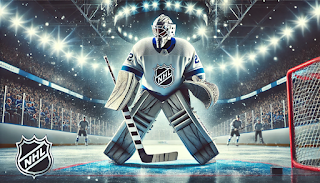The goalkeeper in hockey plays a crucial role. They are the last line of defense. Their job is simple: stop the puck. It’s not easy and the goalie must be quick. They need good hand-eye coordination. They wear specialized gear, including a mask, pads, gloves, and a stick. The gear helps protect them and block shots. Goalkeepers organize the defense around them during face-offs to stay sharp. They are always alert, even when little action happens. They control the puck after a save. They decide when to pass or clear the puck.
Key Goalie Statistics Explained
Fans love watching goalkeepers in the NHL make saves. Their performance can keep a team in the game. It’s no surprise fans get excited about saves. Fans love big saves, especially multiple ones. During the off-season, fans miss watching goalies. They choose a $5 deposit casino australia where they can play fast hockey-themed games. Fans can play quick hockey slots and other titles. Others bet on hockey games, even on certain players’ performances. These activities help fans stay close to the sport and challenge themselves with hockey-related predictions.
Here are a few important goalie stats:
- Save Percentage (SV%. This shows the number of shots a player stops. A higher percentage means the keeper stops more pucks.
- Goals-Against Average (GAA). This measures goals a player allows per game. A lower GAA means he allows fewer goals.
- High-Danger Save Percentage. This shows how well a player handles shots from close range. A good score means he is great at stopping critical shots.
How Goalie Statistics Influence Team Strategy
A goalie with a high save percentage can change the game. A team may become more aggressive in attack. They will trust their keeper to stop pucks. A high GAA may lead to a more defensive strategy. A team will adjust. They will focus on preventing chances and reducing risk.
Teams adjust their approach based on the NHL goalie’s stats. If the player excels in saving high-danger shots, the team may take more risks. They might pressure the other team to take more low-percentage shots. If the player struggles with rebounds, the defense will step up. They will focus on clearing the crease and limiting second chances.
Adjusting Offensive Strategies
Teams adjust their offensive approach based on keeper stats. A goalie with a high save percentage could make teams play differently. Coaches might tell players to shoot from different areas. They might focus on shots the defender struggles to stop. Teams may target weaker spots on a goalie’s body. They might also aim for rebounds or tips. A player with a low GAA may prompt a more aggressive offense. They might create opportunities to test the defender’s ability. If he has a high save percentage, a team could try different player matchups. They may put their best shooters on the ice to break the rhythm.
Defensive Adjustments
Defensemen and coaches change strategies depending on goalie stats. If a keeper is struggling, the defense might tighten up. They may focus on protecting the crease. Defensemen could stay closer to the defender to block extra shots. A player with a low save percentage may lead to safer plays. The defense might take fewer risks to help the goalie. If a goalie faces danger shots, the defense might work to clear those opportunities. Coaches might also change the lines to protect the net. This could reduce the number of odd-man rushes or breakaways the keeper faces.
The Evolution of Goalie Metrics and Modern Strategies
Modern analytics have changed the way teams test goalkeepers. New stats like expected goals against and rebound control give a deeper understanding. These metrics help NHL teams check a goalie’s true impact. They look beyond save percentage or GAA. Coaches now focus on where and when the shots happen. A goalie might stop a lot of pucks but let in high-danger shots. This shows areas of weakness that coaches need to address.
Here are some modern metrics:
- Expected Goals Against (xGA). This is an advanced stat that shows how many goals a keeper should have allowed based on shot quality. It helps measure how well a goalie handles tough shots.
- Rebound Control. This measures how well a goalkeeper handles pucks that bounce off them after a save. A player with good rebound control reduces scoring chances for the other team.
- High-Danger Save Percentage. This shows how good a goalie is at stopping shots from dangerous areas, usually near the net. A higher percentage means performance in critical moments.
- Goals Saved Above Average (GSAA). This stat compares a player’s performance to league averages. It shows more or fewer goals a player has allowed than expected.
These newer metrics influence game strategies. Teams use them to identify weak spots in a goalie’s game. Based on these stats, teams might adjust how they play offense or defense. A defender who struggles with rebounds might force teams to change their offensive approach. Teams could focus on tips or second-chance opportunities to score. They give coaches a clearer picture of what is happening on the ice.



